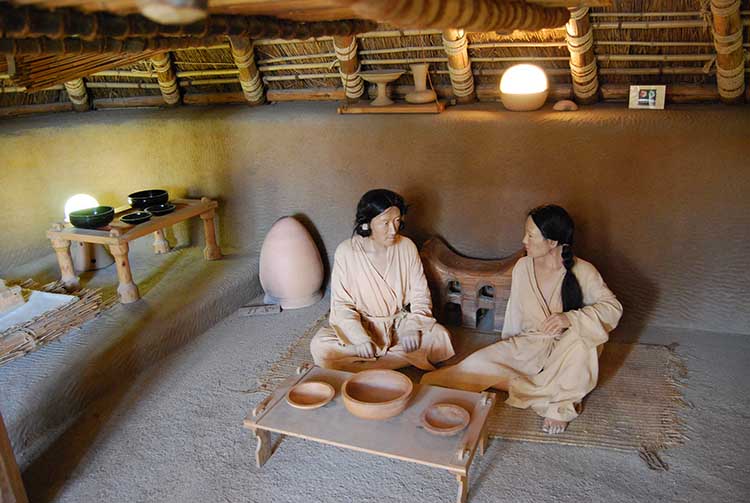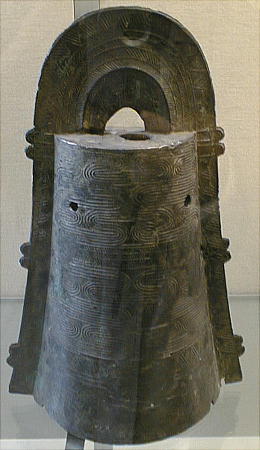The Yayoi period is associated with Bronze and Iron Age age in the history of Ancient Japan. Yayoi period traditionally dated from 300 BC to AD 300. Yayoi period named after the archeological site near Tokyo.
The Final Jomon culture, in essence a Mesolithic culture (although they display Neolithic traits, such as pottery-making), thrived in Japan from the 8th to the 3th century B.C., when it was displaced by a wave of immigrants from the mainland. These were the Yayoi, and their origins lay in the north of China. Northern China was originally a temperate and lush place full of forests, streams, and rainfall. It began to dry out in next few thousand years. This desiccation, which eventually produced the Gobi, one of the largest deserts in the world. This area were occupied by humans in south and east. These peoples pushed into Korean land and displaced indigenous populations.
These new neolithic and eneolithic people were displaced by a new wave of immigration’s from northern China and a large number of that humans crossed over into the Japanese islands. For this reason, the languages of the area north of China, the language of Korea, and Japanese are all in the same family of languages according to most linguists.
The Yayoi people brought agriculture, the working of bronze and iron, and a new religion which would eventually develop into Shinto (which wasn’t given this name until much, much later). What these immigration did to the indigenous peoples, there are several possibilities. According to one theory, which is widely accepted, the waves of Yayoi immigrants were very small. People from Yayoi culture brought new technologies, they were nevertheless assimilated into the native Jomon culture.



Some historians believe that the Jomon language is an Austronesian language, that is, that the Jomon were more closely related to south Pacific islanders and that Japanese is still largely a Pacific island language. Therefore, some archeologists believe that the Yayoi culture displaced the indigenous Jomon and thus ended their culture permanently. The Yayoi displaced the indigenous language, social patterns, and religion of the original inhabitants. In this view, Japanese culture is a foreign import deriving ultimately from the north of China and ancient Korea, a view that is not popular among the modern Japanese.
Whatever the origins of Japanese culture, Japanese language, social structure, and religion can be dated in time of Yayoi immigrants. So it can be concluded that the Yayoi culture were a new beginning in Japanese culture compare to Jomon period. The transition was huge, far surpassing. Japanese Jomon culture changed overnight with these new immigrants from Yayoi culture. Eight thousand years of Jomon cultural placidity was dramatically hoisted into the new era.
The Yayoi lived in clans (uji) were headed by a single patriarchal ruler who served as war-chief and as a priest. Each clan of Yayoi was associated with a single god. The ruler of each clan was responsible for all the ceremonies associated with that god. These gods, called kami. God usually represented forces of nature or any other wondrous aspect of the world. When one clan conquered another, it absorbed its god into its own religious practices. In this way, the Yayoi culture slowly developed a complex pantheon of Gods (kami). This pantheon represented in their hierarchy the hierarchy of the clans .



The Yayoi people lived primitively. They had no system of writing or monetary system. Yayoi people dressed largely in clothes made from hemp or bark. Marriages in Yayoi clans were frequently polygamous (marriage between one man and several women), but women held a fairly prominent place in the society of the clans. It is probable that women even served as clan-heads or priests. This theory comes from the Chinese histories that first discuss the Japanese.
The relationships between the Yayoi clans were complex. Slowly, territorial conflict between clans gradually produced what came close to small states. The first Japanese state, however, would be built on the Yamato peninsula, the area into which Chinese influence began around 200 AD. The earliest written records about people in Japan are from Chinese sources from 57 AD with name “Wa”. The name Wa, is Japanese pronunciation of an early Chinese name for Japan. First mentions Yamataikoku (also name for Japan) and Queen Himiko was in the 3rd century AD. The location and the identity of Queen Himiko still not completely known.
